Tagmosis - Guías de estudio, Notas de estudios & Resúmenes
¿Buscas las mejores guías de estudio, notas de estudio y resúmenes para Tagmosis? En esta página encontrarás 6 documentos de estudio para Tagmosis.
All 6 resultados
Ordenador por
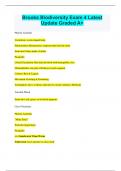
-
Brooks Biodiversity Exam 4 Latest Update Graded A+
- Examen • 25 páginas • 2024
-
Disponible en paquete
-
- 9,49 €
- + aprende más y mejor
Brooks Biodiversity Exam 4 Latest Update Graded A+ Phylum Annelida Vermiform: worm shaped body Homonomous Metamerism: segments that look the same Setae aka Chatea made of chitin Parapodia Closed Circulation: Has heart & blood with hemoglobin (1st) Metanephridia: one pair of kidneys in each segment Coelom: Best & Largest Movement:Crawling & Swimming Trochophore larva: evidence that they're closely related to Mollusks Annelids Blood Some have red, green, or no blood pigment. Cla...
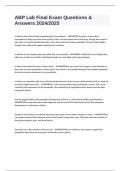
-
ABP Lab Final Exam Questions & Answers 2024/2025
- Examen • 14 páginas • 2024
-
- 8,54 €
- + aprende más y mejor
ABP Lab Final Exam Questions & Answers 2024/2025 In Nereis what role do the parapodia play in locomotion? - ANSWERSThey play a major role in locomotion as they can move them to help 'swim' and stay above the ocean floor, though they want to stay. Each is on both attached laterally to the sides and have chaetae extended. They are like paddles though more often push against substrate for crawling. In Neireis do the chaetae play any visible role in locomotion - ANSWERSIt is difficult to s...
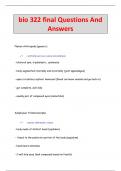
-
bio 322 final Questions And Answers
- Examen • 24 páginas • 2024
-
Disponible en paquete
-
- 11,87 €
- + aprende más y mejor
Phylum Arthropoda (specifics) ~ - tagmosis: fusion of metameric body plan into functional units - growth by molding termed ecdysis - functional cilia absent (except sperm in some) - cuticle forms a rigid exoskeleton Class Hexapoda (specifics) ~ - ph. Arthropoda, sub uniramia - specialized mouth parts - metamorphosis — hemimetabllous dvlpmt - eggs > nymphs > adults - juvenile resembles adults - ie crickets, grasshoppers — homometabolous - eggs > larvae > pupa ...
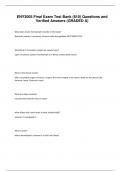
-
ENY3005 Final Exam Test Bank (810) Questions and Verified Answers (GRADED A)
- Examen • 129 páginas • 2024
-
- 10,92 €
- + aprende más y mejor
What does insect hemolymph transfer in the body? Nutrients, wastes, hormones, immune cells and peptides, BUT NEVER O2!! What kind of circulatory system do insects have? open circulatory system: hemolymph is in direct contact with tissues Brainpower Read More What is the dorsal vessel? Main circulatory organ of insects. It spans the entire length of an insect's body on the dorsal side. Anterior: aorta. Posterior: heart What are Alary muscles? muscles that hold the heart in...

-
BODY SEGMENTATION - STRUCTURE AND MODIFICATIONS OF INSECT ANTENNAE, MOUTH PARTS AND LEGS, WING VENATION, MODIFICATIONS AND WING COUPLING APPARATUS & SENSORY ORGANS
- Notas de lectura • 24 páginas • 2022
-
- 7,59 €
- + aprende más y mejor
BODY SEGMENTATION - STRUCTURE AND MODIFICATIONS OF INSECT ANTENNAE, MOUTH PARTS AND LEGS, WING VENATION, MODIFICATIONS AND WING COUPLING APPARATUS & SENSORY ORGANS. Insect body is differentiated into three distinct regions called head, thorax and abdomen (grouping of body segments into distinct regions is known as tagmosis and the body regions are called as tagmata).
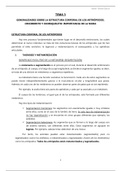
-
Tema 3: Generalidades sobre la estructura corporal de los artrópodos. Crecimiento y exoesqueleto: importancia de la muda
- Notas de lectura • 6 páginas • 2018
- Disponible en paquete
-
- 2,99 €
- + aprende más y mejor
Se explican los procesos de tagmosis y metamerización, indicando la diferencia entre la segmentación homómera y heterómera. Respecto al exoesqueleto, se define, se indica su principal componente y se explica el proceso de muda y de esclerificación. Finalmente, se hace referencia a los principales apéndices articulados de los artrópodos.

¿Sabías que, de media, un vendedor en Stuvia gana 76 euros al mes con la venta de recursos de estudio? Hmm, pista, pista. Descubre todo sobre cómo ganar en Stuvia


